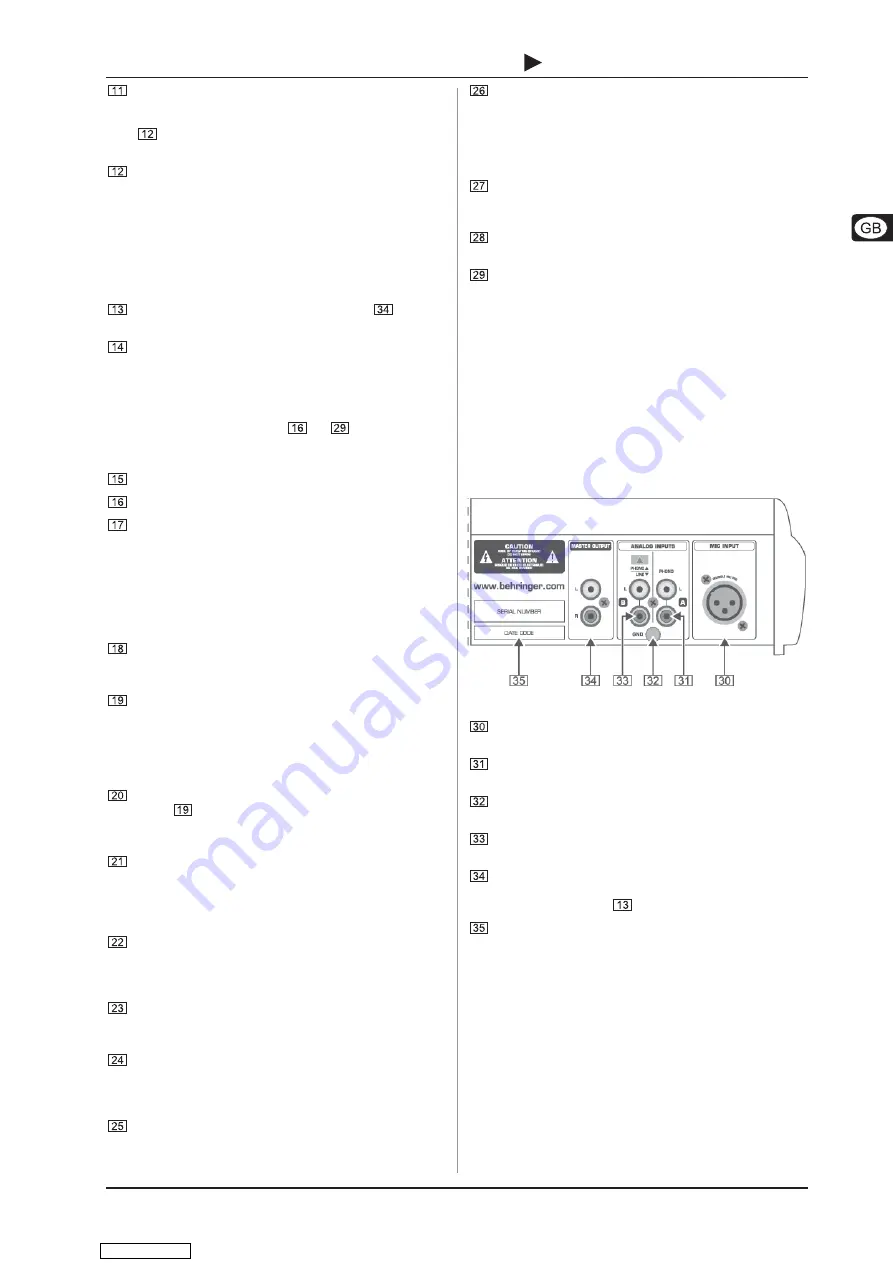
9
B-CONTROL
DEEJAY
BCD2000
3. CONTROL ELEMENTS AND CONNECTIONS
The
PFL MIX
control determines the headphone volume
ratio between deck A and deck B. Both signals can be heard
in both earcups (stereo). When the PHONES SPLIT button
is pressed, it controls the volume ratio between the
signals of deck A in the left and deck B in the right earcup.
PHONES SPLIT/MASTER OUT
button. In the position
PHONES SPLIT (press button briefly) the signals of both
decks are separated in the headphones. In this case, they
will be audible in mono in each earphone. In the position
MASTER OUT (keep button pressed until button LED starts
flashing), the same signal is applied to the headphones
output and the master outputs. This allows you to control
your crossfader skills, for example, when practicing at home
or when there is nothing connected to the master outputs.
Set the volume of the MASTER output
with the
MASTER OUTPUT
control.
The
POWER ON
-LED lights up when the BCD2000 is
switched on.
The deck sections A and B
The control elements of decks A and B are the same. However,
some of them are grouped the opposite way round. We will
therefore describe the elements
to
only once. All of
these control elements refer to the software functions which can
be remotely controlled from the BCD2000.
The crossfader is used to fade between deck A and deck B.
Use the
GAIN
control to adjust the input signal.
Each deck features a 3-band equalizer (
HI, MID
and
LOW
)
with kill feature. Thus, the signal can be attenuated to a
much greater extent (-36 dB) than it can be raised (+12
dB). The
CUT
buttons below the EQ controls give you
maximum signal attenuation at the touch of a button. In this
way, you can fade out a specific frequency range of a music
piece completely and produce interesting filter effects. For
beat juggling, too, this function is a must.
When you press the
BACK TO TOP
button, the song position
pointer is set back to the beginning of the piece. Playback
stops even though the deck has just played!
LOOP IN/END
determines the start and end points of a
sequence to be played back several times in a loop. Press
the button to set the loop start point, and then again to set
the end point. Once the end point has been set, the loop
starts, i. e. the sequence is played back from the start point
and is repeated until you press the LOOP OUT button.
LOOP OUT
deactivates the loop which was started with
button
. Depending on the setting chosen in the software
configuration, the loop is either deleted directly or repeated
one more time.
SYNC SLAVE
is a function which allows you to automatically
adapt the tempo of two music pieces to each other. The
song whose
SYNC SLAVE
button is pressed, is auto-
matically adapted to meet the tempo of the song currently
playing.
The scratch function is usually active only when the deck is
in pause mode. The
SCRATCH
button activates the scratch
function of the scratch wheel also during playback (PLAY
button pressed).
With the
VOLUME
fader, you can control the volume. While
mixing, it is important to have the same volume in both
decks.
Use the
CUE
button to set and select the cue points. Press
the CUE button a little longer to delete the currently selected
CUE point. How to use the CUE function is described in
chapter 5.2.
Playback is started with the
PLAY/PAUSE
button. Press
this button again to stop playback. Press the button once
again to resume playback from the position where it stopped.
BEND
button. Press the
UP
button (+) to raise the playback
tempo. Press the
DOWN
button () to slow down the
playback tempo. With this function you can synchronize the
beats of two pieces currently running. In the Configuration
window of the B-DJ software you can adjust the percentage
by which the tempo is changed.
The pitch fader provides continuously adjustable playback
tempo control. The pitch range can be adjusted in the
Configuration menu.
Use the
SEARCH
buttons to move forward or backward in
a song.
The function performed by the scratch wheel depends on
whether the deck is in PLAY or PAUSE mode.
PLAY: pitch bend is active. This function mimics the
pitching technique (accelerating and slowing down the
turntable to adapt the rhythm of two vinyl records to each
other). Turn the scratch wheel clockwise to raise the
playback tempo. Turn it counter-clockwise to slow down
the tempo. However, if the SCRATCH button is pressed,
you can also scratch during playback.
PAUSE: Cue Search is active: You can both scratch and
locate exact cue positions.
3.2 The rear panel
Fig. 3.2: The rear-panel audio connectors of the BCD2000
MIC INPUT
. The
MIC IN
connector is the balanced XLR
input for your dynamic microphone.
The analog input A (
PHONO
) is used for connecting a
turntable.
Connect the ground cable on your turntable to the
GND
screw on the BCD2000 housing.
Analog input B. To connect a CD player or tape deck to this
input, set the switch to
LINE
.
Connect the
MASTER
OUTPUT
to your power amplifier. It
provides the main output signal, which can be adjusted with
the MASTER control
.
SERIAL NUMBER
.
Downloaded from



































